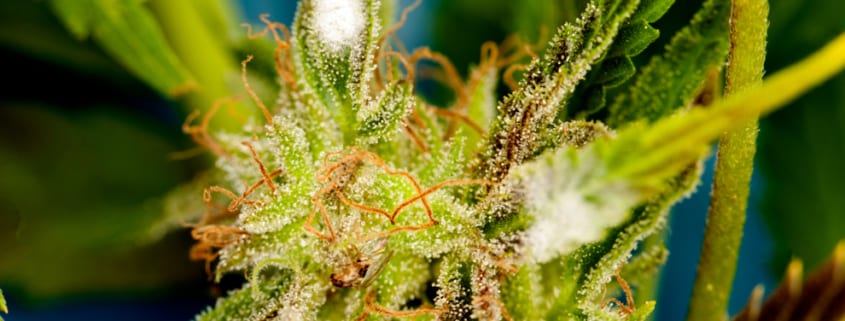Industrial hemp is traditionally more resistant to diseases and pests than many other cash crops; however, hemp can be susceptible to mold. This is especially true for hemp grown for CBD or CBG. Hemp flower tends to absorb moisture, making it a tempting target for mold. If mold does appear in your hemp crop, it can grow quickly, damaging your plants, lowering your yield, or even ruining your harvest. If you plan on growing industrial hemp, then you need to know how to prevent and treat mold on hemp plants.
A Quick Introduction to Mold
Mold may be an enemy to farmers, but it actually serves a useful purpose in the greater ecosystem. This fungus is made up of countless tiny spores that drift through the air and land on surfaces. Mold is everywhere and can be virtually impossible to completely eliminate. (It even started growing aboard the International Space Station!) Mold spores feed by releasing enzymes that break down organic material, such as plants.
In the wild, mold serves as an important decomposer, breaking down dead plants, animals, and waste and returning those particles back to the soil. In order to grow and thrive, mold needs the right type of environment. The key ingredients that mold loves are:
- Moisture
- Humidity
- Stagnant air
- Darkness
The best hemp mold prevention strategies focus on depriving mold of the ingredients it needs to thrive.
The Most Common Types of Hemp Mold
So far, scientists and researchers have discovered over 100,000 different types of mold, but you don’t need to be on the lookout for all of them. In fact, many types of mold are harmless or can even be helpful. Instead, farmers should focus on just a handful of mold that can damage hemp plants, including:
Gray Mold
Gray mold often attacks plants through openings or wounds in the plant, though it can also infect healthy plants. The calling card of gray mold is brown or gray-brown spots on wet hemp buds. Also, look for yellow discoloration on stems. Gray mold will destroy hemp flowers, making it unhealthy to smoke.
Powdery Mildew
If you notice that your plants look like they were dusted in white flour, you may have a case of powdery mildew. This type of mold loves hot, humid conditions with little airflow. Look for powdery mildew on the foliage of hemp plants. Aside from powder-like spots on the leaves of plants, also look for yellow-to-brown ascomata.
White Mold
White mold can be distinguished by dark brown lesions on the stems of the hemp plant. Stems with lesions break and shred easily, revealing an unappealing cloud of mycelial growth.
Sooty Mold
As its name implies, sooty mold appears like a fine layer of soot scattered across the leaves of your hemp plant. Sooty mold doesn’t directly feed on a hemp plant. Instead, it eats the leavings of common plant insects, like aphids, leafhoppers, and whiteflies. While sooty mold won’t directly harm hemp plants, it can cover the surface of hemp leaves, disrupting photosynthesis and damaging the overall growth and health of the plant.
Fusarium
Perhaps the scariest hemp mold for any farmer to face, fusarium can strike lightning-quick and destroy an entire hemp crop. Fusarium attacks from below, damaging the root systems of a plant. By the time a farmer notices that their hemp plants are beginning to wilt, it’s often too late. The roots of the plants are already destroyed beyond repair. If a full-blown fusarium infection occurs, there is little a farmer can do to save the crop (which is one reason why hemp crop insurance can be so valuable!).
How to Prevent Mold on Hemp
The best way to prevent hemp mold is to remove the elements that help mold thrive. The easiest way to do this is to grow hemp inside of a greenhouse where you have much more control over the growing environment. Greenhouses can be costly, and not every farmer has the budget or infrastructure to grow their hemp crop indoors. If you don’t have a greenhouse, you can still lower your chances of finding moldy hemp in your field one day.
Here are several hemp mold prevention techniques for greenhouse growers and outdoor crops.
Indoor Hemp Mold Prevention Recommendations
- Install a hygrometer in your greenhouse to monitor the temperature and humidity of your grow room.
- Set up an efficient exhaust system within your grow house to keep humidity under control.
- Install fans in the room to blow above the plants and under them. Good airflow can help prevent mold from getting a foothold onto your plants.
- Add a dehumidifier to your grow house to eliminate humidity. As your plants reach maturity, they will require more water, where their leaves will release into the air, creating more humid conditions inside the grow house.
- Replace your HVAC filters on a monthly basis.
- Install high-efficiency particulate air (HEPA) filters to catch as many mold spores as possible.
- Use UV lights in your HVAC system to kill off mold spores.
- If you have the budget, consider installing antimicrobial flooring.
- Consider defoliating your plants as they reach maturity. Cutting off some of the bottom leaves will increase airflow to your plants and lower humidity levels. Cutting off bottom buds will also allow your plants to redirect their energy to growing larger top buds.
- Carefully inspect your plants every day and be on the lookout for the most common types of hemp mold.
Outdoor Hemp Mold Prevention Techniques
- Plant your hemp in a field with the most direct sunlight possible.
- Give your seeds or starts some space to promote airflow and make it more difficult for mold to infect multiple plants.
- If you live in an area that gets cold temperatures and rain in the fall, consider purchasing early finishing varietals or autoflower hemp seeds.
- If a long and heavy rain is predicted, cover your crop with tarps to help prevent water-soaked buds.
- Set up fans in your field after a rain to dry your plants and create more airflow.
- Install a drip irrigation system if you have the budget. Drip irrigation feeds water directly to the root systems of the plant, unlike pivot irrigation, which can result in wet leaves and lead to hemp leaf mold.
- Inspect your fields each day and be on the lookout for moldy hemp.
What to Do If You Spot Mold on Hemp Plants
Mold can attack your hemp plants at any stage of growth or even after the harvest as you dry and cure your hemp, so you must always be vigilant. If you do spot moldy hemp, first identify the scope of the problem. If you notice just a few spots on the leaf of a single plant, you may be able to defoliate that plant and save it. However, if the plant is already deeply infected, then excise the plant and carefully monitor the plants in close proximity to the infected plant. If your plants are wet, use fans to dry them.
If you notice a larger infestation in your crop, your best option might be to eliminate the infected plants and immediately harvest the rest of your crop. This is especially true if your hemp flower is wet and you don’t have the means to dry them.
Be sure to toss any infected hemp buds. Moldy hemp buds aren’t just unpleasant to smoke, they can endanger the health of smokers, especially someone who is immunocompromised. Don’t take that risk!
Choose Hemp Seeds That Are Resistant to Mold
One of the best ways to prevent moldy hemp is to choose hemp seeds strains that are genetically bred to resist mold and other diseases. At High Grade Hemp Seed, we have spent years developing some of the most robust hemp strains available on the market. Contact us today to learn how our seeds can protect your future hemp harvest from mold.



